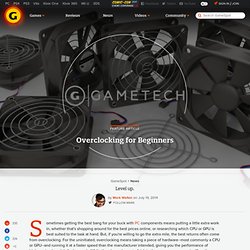

eMMC vs. SSD: Not All Solid-State Storage is Equal. Not all solid-state storage is as fast as an SSD.

“eMMC” is the kind of flash storage you’ll find in cheap tablets and laptops. It’s slower and cheaper than a traditional SSD you’d find in more expensive computers. eMMC storage has a lot in common with SD cards. It’s all flash memory, but — just as an SD card wouldn’t be as fast as a speedy solid-state drive — eMMC storage can’t compete with an SSD, either.
USB Sticks and SD Cards Contain Flash Memory, But… Flash memory — typically NAND flash memory — is found in USB flash drives and all the different types of SD cards you’d buy. Overclocking for Beginners. Sometimes getting the best bang for your buck with PC components means putting a little extra work in, whether that's shopping around for the best prices online, or researching which CPU or GPU is best suited to the task at hand.

But, if you're willing to go the extra mile, the best returns often come from overclocking. For the uninitiated, overclocking means taking a piece of hardware--most commonly a CPU or GPU--and running it at a faster speed than the manufacturer intended, giving you the performance of higher-priced models for less cash. While there's an element of risk to the process--you can significantly shorten the life of your components or permanently damage them if something goes awry--if you're sensible, disasters are rare.
The process of overclocking isn't as complicated as some would have you believe either, and with a bit of computing know-how, and some patience, it's possible to significantly boost your PC's performance with just a few tweaks. The History of Data Storage. 10 Crazy Ways to Cool Your Computer. Due to increased heat produced by overclocked components, an effective cooling system is necessary to avoid damaging the hardware.

Overclockers go to great extents to keep their valuable hardware cool in the face of ridiculous speeds. Here are a few examples of MHz junkies that might have gone just a little too far while trying to keep their computers cool (in no particular order): The Turbocharger: This guy had an old turbocharger lying around and decided to put it to good use, pumping air into his flaming hot case faster than any 90mm fan out there. Liquid Nitrogen Cooled: The Reigning Champion, used again and again with every new chip released. The only way to go for a new 3DMark record.
This article was written by SpeedingComputer.com Computer News. Supercomputer Made from 1,760 PlayStation 3 Consoles. Top 10 Ways to Turn Your Retired Gadgetry into the Technology of the Future. Car Gadgets & Accessories. Videogame Statistics. Education Database Online Videogame Statistics Embed the image below on your site <a rel="nofollow" href=" src=" alt="Videogame Statistics" width="600" height="2282" border="0" /></a><br />Source: <a href=" Education</a> Source: Online Education Video games have become quite popular over the last 30 years, so popular in fact that that fully 65% of American households play video games and this number is growing.
Of that 65% of the US population, 18-49 year olds make up the largest percentage of gamers at 49%. Gamer is broad term so let us look at the breakdown of gender versus console preference. As most gamers will tell you the two single largest markets for video games are Japan and the US. See Also Local Gaming Schools Local Art and Design Schools © 2014 Education Database Online | Privacy Policy | Contact. Google is way bigger than you realize. Gizmodo has posted a visual representation from Intac showing the approximate number of dedicated servers that major tech companies own.
When you speak in terms of numbers, it becomes hard to comprehend just how large these server farms have become. Intel, for example, is estimated to have around 100,000 servers in its arsenal, while Facebook, AT&T, and Time Warner Cable, all fall between 20,000 and 30,000. Without being able to see these server farms with your own eyes, these statistics are merely tossed aside as nothing more than interesting facts. The history of PC hardware, in pictures. We all use personal computers and we all take them for granted in our everyday lives.

It’s easy to forget that PCs have only been around for a couple of decades, and initially were nowhere near the powerhouses we have on our desks today. For example, did you know that the first “portable” computer weighed 25 kg (55 lb) and cost close to $20,000, that the first laser printer was big enough to fill up most of a room, or that you basically had to build the first Apple computer yourself? This article takes a look at the time when the computer equipment we now take for granted was invented and what it looked like back then.
The first computer mouse The first computer mouse was invented in 1963 by Douglas Engelbart at the Stanford Research Institute.